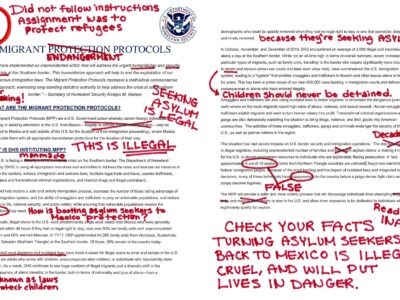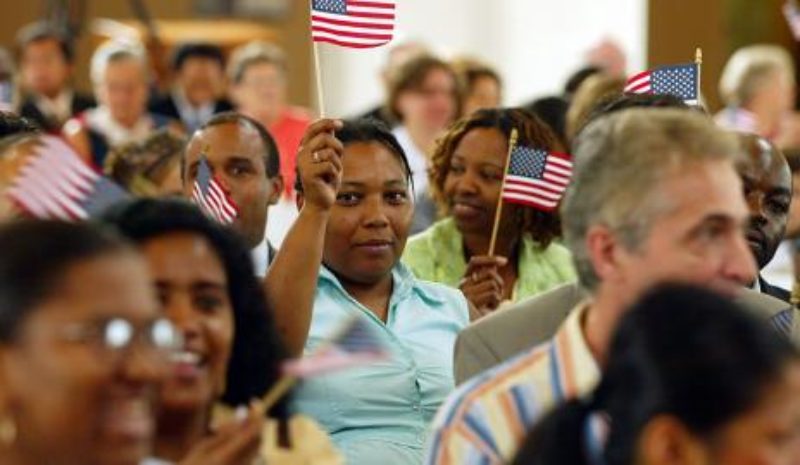“Nothing Humane About This Process”
Biden Administration Launches “Remain in Mexico” Revamp at El Paso Port of Entry
By Julia Neusner, Ana Ortega Villegas
The Biden administration began returning asylum seekers and migrants to Mexico in its revamped version of the infamous “Remain in Mexico” program (RMX) on December 8th, 2021 at the El Paso Stanton Street port of entry in Texas. The RMX program, officially and absurdly dubbed the “Migrant Protection Protocols,” was originally implemented by the Trump administration in 2019. It requires migrants and asylum seekers arriving at the southern border to wait in dangerous border cities in Mexico for months or years while their claims are pending in U.S. immigration courts. Though the Biden administration ended RMX 1.0 earlier this year, it is now restarting RMX in the wake of several court rulings in a case filed by the states of Texas and Missouri. The administration plans to soon expand the policy border-wide.
In our roles as Human Rights First’s Advocacy Strategist and Associate Attorney for Refugee Protection, we spent a week in Ciudad Juárez monitoring the Biden administration’s rollout of “RMX 2.0.”
During the first week of RMX’s implementation, the Biden administration returned 114 people from Cuba, Colombia, Ecuador, Nicaragua, and Venezuela to Mexico. Each morning, we watched RMX enrollees be returned to Mexico through a bridge connecting El Paso, Texas with Ciudad Juárez. U.S. Customs and Border Protection (CBP) agents escorted across the bridge single-file lines of men in DHS-issued sweatsuits and elastic slip-on shoes (the first two wore only socks with flip-flop sandals), clutching plastic zip-lock bags containing their phones, chargers, identification documents, and sometimes tattered bibles. Mexican immigration (INM) officers met the procession at the center of the bridge, where a plaque marks the boundary between the two countries, then marched the returnees down the Mexican side of the bridge to a space with tents erected for the purpose of facilitating RMX returns. Though we were unable to observe what went on inside the tents, we learned that INM issued the returnees temporary visas providing work authorization in Mexico that would expire on the date of each returnee’s first RMX hearing (which, for those returned during the first week after RMX 2.0’s implementation, is scheduled for early January). Officials from INM and the International Organization for Migration (IOM) provided a brief presentation for the asylum seekers and migrants turned away by the United States under RMX before transporting them to a migrant shelter in Ciudad Juárez operated by the municipal government.
Those returned under RMX 2.0 face grave danger in Ciudad Juárez, a region for which the U.S. State Department has issued a level 3 travel advisory warning (the second highest possible rating) due to the high risk of kidnappings and violence. Just as the fatally flawed RMX 1.0 policy inflicted tremendous suffering and chaos, the Biden administration’s restarted RMX 2.0 is certain to endanger lives. Human Rights First tracked at least 1,544 kidnappings and other reports of attacks on people who were put into RMX 1.0 under the Trump administration in 2019 and 2020, and at least 7,647 violent attacks on individuals stranded in Mexico in 2021 due to the Biden administration’s continued misuse of Title 42 public health authority to block and expel migrants and asylum seekers at the border. Those returned under RMX 2.0 now face the same danger.
DHS further endangered some asylum seekers by scheduling their U.S. immigration court hearings early in the morning the following month, which will require them to travel through Ciudad Juárez at night. Several people we interviewed showed us written instructions from CBP to appear at their hearings at the El Paso port of entry at 4:30 a.m. Advocates had previously condemned the administration’s practice of scheduling early morning hearings requiring nighttime travel. Human Rights First has documented numerous instances of asylum seekers in RMX 1.0 being kidnapped or attacked en route to their U.S. immigration court hearings, including in Ciudad Juárez.
Under the Biden administration RMX, DHS has stated that it will affirmatively screen people for fear of return to Mexico before returning them to Mexico. Almost all the 16 returnees we interviewed reported that they had been asked if they feared returning to Mexico. Those who indicated a fear of return to Mexico underwent what they estimated to be a 30 to 60-minute interview – which is labeled as a “non-refoulement” interview. The interview is conducted over the phone by an asylum officer and a translator. The interviewees reported that they were asked to justify their fear of returning to Mexico. Several returnees reported that they felt uncomfortable during the interview and described the officer asking the questions as “harsh” and “rude.” One Nicaraguan man felt that during his interview, the officer had already made up his mind to send him back to Mexico. “There is nothing humane about this process,” he said.
Though administration guidance indicates that no one demonstrating “a reasonable possibility” of persecution or torture in Mexico would be returned under the program, everyone we interviewed had already been the victim of violence or criminal targeting by police or other government officers in Mexico. Several had been kidnapped or had escaped attempted kidnappings, including a man who had been kidnapped and tortured with electrocution and beatings for weeks during the previous month. One Nicaraguan asylum seeker told the officer during his interview that he feared returning to Mexico because, within the past month, he had been kidnapped near the border for eight days until his family paid ransom. He said, “I was very scared. They said, ‘If you don’t pay, we’ll kill you.’” The man had also been extorted by Mexican police who threatened to sell him to a cartel if he failed to pay them. The Mexican police officers abducted two women from the group with whom he was traveling and nobody has heard from them since. Though he explained this to the U.S. asylum officer, he was returned to Mexico under RMX.
The Biden administration had also promised that individuals subject to RMX would have the opportunity to consult lawyers before the non-refoulement interview. Almost everyone we interviewed reported that they had not spoken with a lawyer. Some reported they were confused about who they were speaking to on the phone during their non-refoulment interview and did not know if a lawyer was on the line. When one Nicaraguan asylum seeker requested to speak with a lawyer, a CBP officer told him the U.S. government would not pay for the lawyer; he’d have to pay himself. The asylum seeker replied that he did not have any money and asked to call his family to ask that they hire a lawyer for him, but the officer refused to let him call his family. “I arrived in the United States with the illusion that my rights would be protected in this country. But there have been many lies. There are no human rights in the United States. I have seen with my own eyes they can do whatever they want to you,” he said.
Prior to being returned to Juárez under RMX, most of the returnees had been detained, on average, for four or five days after crossing the border into the United States. Some had been detained for more than a week. All reported that during the time they were detained in El Paso, they were not permitted to make any phone calls and could not inform their worried families of their whereabouts. Their families had to wait to learn of their fate until after their return to Mexico. Several returnees reported that they were forced to spend days without washing themselves or brushing their teeth. Upon their arrival, DHS officers had seized their toothbrushes, along with their clothing, shoes, and other personal possessions, then issued them the uniform sweatsuits and slip-on shoes. Officers told some of them that it was their protocol to dispose of migrants’ belongings, because they might be “infected with diseases.” Consequently, the men had to wear for days the same clothes and undergarments they were issued in detention. When the RMX returnees arrived at the municipal government shelter, some sorted through a pile of second-hand clothing items that had been donated to the shelter. With temperatures dipping below 40 degrees Fahrenheit at night during the desert winter in Juárez, the DHS-issued sweatsuits weren’t warm enough. But options were limited. One Venezuelan man emerged from the room with the donated clothing wearing a too-small women’s trenchcoat. Others awkwardly layered button-down shirts over their sweats.
At least three people who were returned under RMX 2.0—two from Nicaragua and one from Venezuela—had been subjected to lateral flights from McAllen, Texas, before they were placed in RMX. All had entered the Texas Rio Grande Valley in late November, 2021. They described horrendous conditions of confinement in McAllen, where they were forced to sleep on the floor in a freezing, overcrowded room, where the overhead lights remained illuminated at all hours, with nothing but a foil blanket to keep warm. After days in these conditions, without being provided any information about what was happening to them, the men were shackled with chains on their hands, ankles, and waists, and taken to an airport, where they waited more than four hours before boarding a plane they had been led to believe would take them to their loved ones in the United States. Once the plane landed in El Paso, DHS agents told them they were being placed in RMX.
During the first week, only adult men were returned under RMX 2.0, although the administration has indicated that women and families are eligible for the program and will likely be included as the RMX 2.0 expands. The men we met were alone, afraid, and incredibly vulnerable. Several told us through tears that they didn’t know anyone in Juárez and had never been there before, that they had no resources to support themselves, and that they were afraid. The youngest man returned during the first four days was a 19-year-old Nicaraguan university student who had to abandon his studies because of the danger he faced related to his family’s opposition to the government. We also interviewed two 22-year-olds from Nicaragua and Venezuela who are confused, afraid, and missing their families. We’ve received phone calls from distraught family members of returnees who had expected their loved ones to join them in the United States, only to find out they would be trapped in Mexico for months. One distressed Nicaraguan American woman is flying across the country to Juárez to visit her brother, who fled Nicaragua to seek U.S. asylum and was among the first people to be placed in RMX. The “single adult men” returned under the program have parents, siblings, wives, and children who miss them and are extremely worried about their safety.
From our time documenting RMX 2.0’s, one thing is clear: RMX was a humanitarian disaster under the Trump administration, and it remains a humanitarian disaster now. The Biden administration’s implementation and expansion of this policy is already endangering the lives of vulnerable asylum seekers and causing untold trauma to those subjected to it. There is no safe or humane way to implement this deeply cruel and unjust program. The Biden administration must end it and restart asylum – now.

